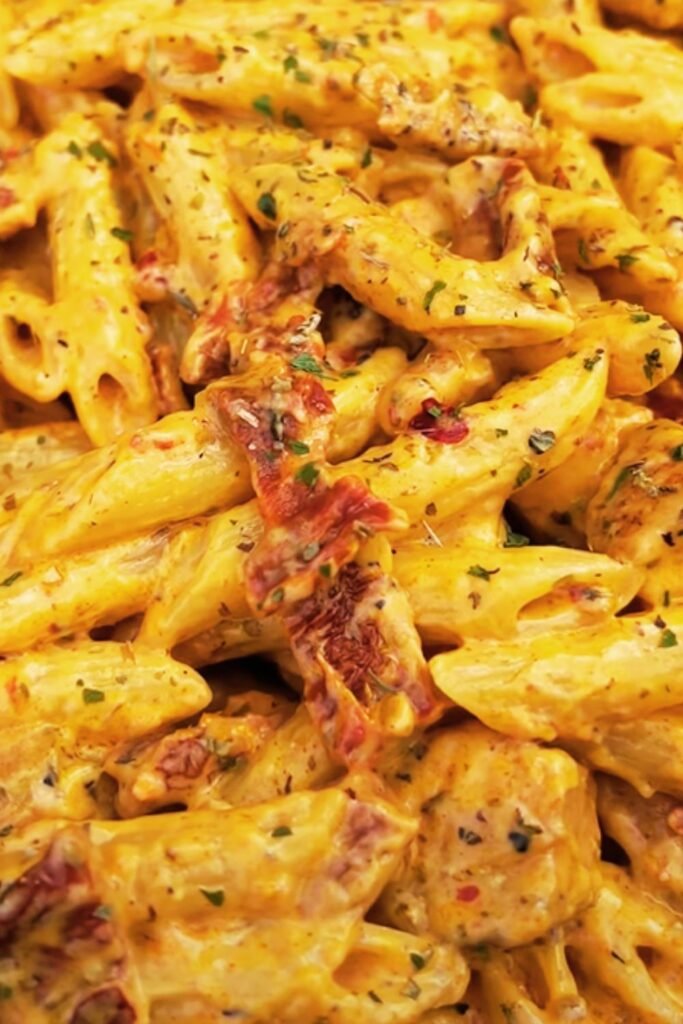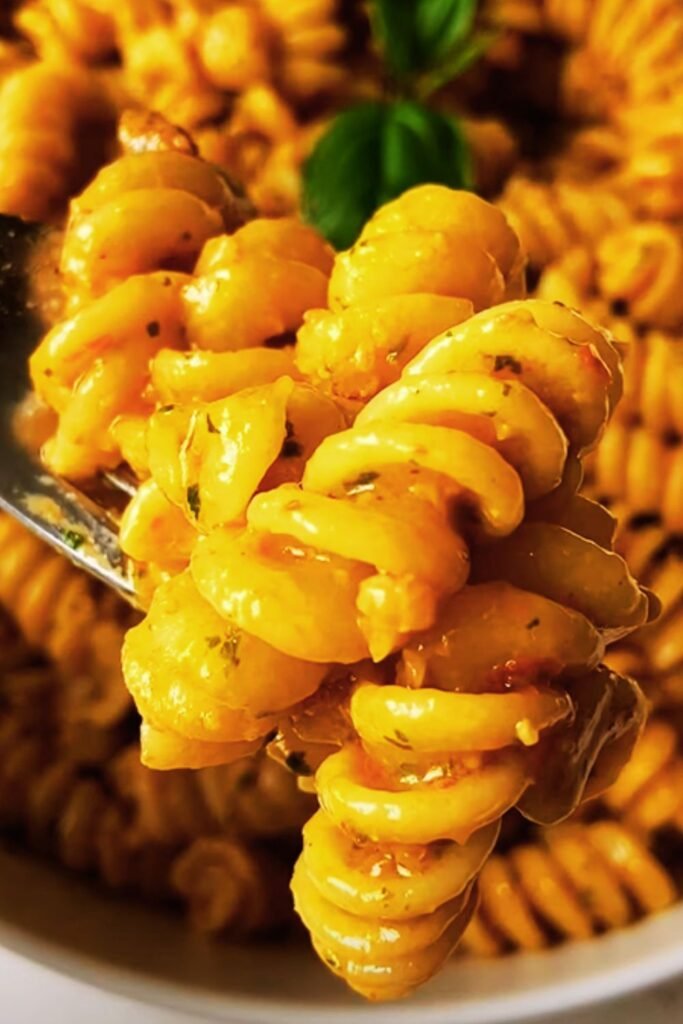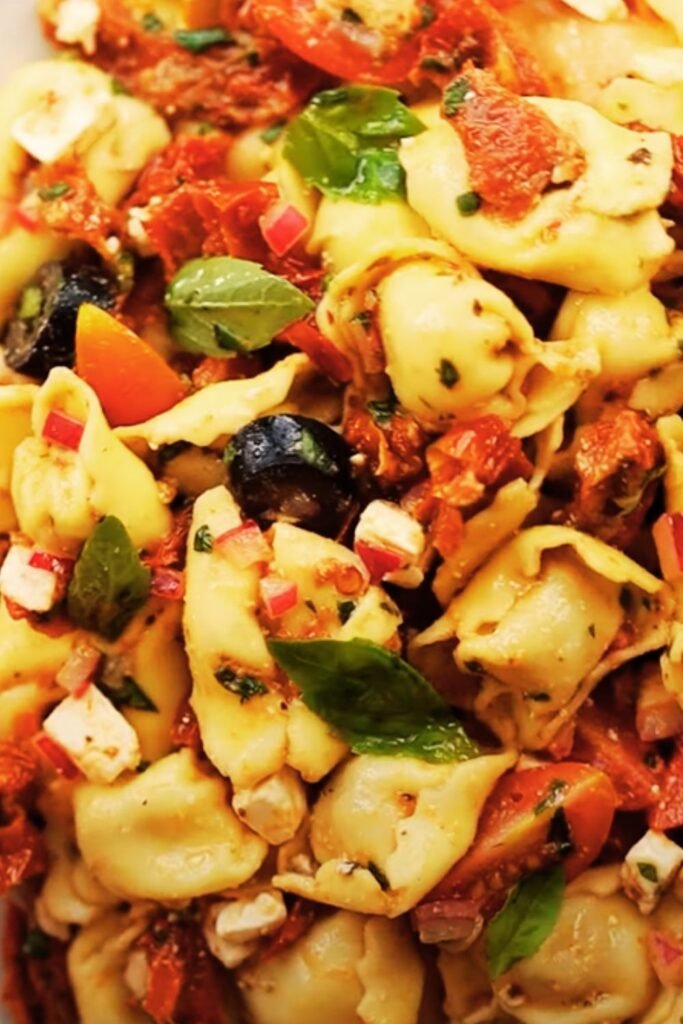There’s something magical about the intense flavor of sun-dried tomatoes that transforms even the simplest pasta dish into something extraordinary. The concentrated sweetness combined with the natural umami quality creates a depth that fresh tomatoes simply can’t match. Today, I’m sharing my absolute favorite sun-dried tomato pasta recipe that I’ve perfected over years of testing and tweaking.
This isn’t just another basic pasta recipe—it’s a celebration of Mediterranean flavors that comes together in less than 30 minutes while delivering restaurant-quality results. Whether you’re cooking for a quiet night in or hosting friends for dinner, this dish never fails to impress.
What Makes This Sun-Dried Tomato Pasta Special
What separates this recipe from others is the careful balance of ingredients and techniques that build layers of flavor. I use both oil-packed and dry sun-dried tomatoes (rehydrated) for different texture elements, combine them with fresh herbs, and finish with a touch of cream that transforms the sauce into something silky and luxurious without being heavy.
The result is a pasta dish with bright, vibrant flavors that somehow manages to be both comforting and sophisticated at the same time. It’s become my go-to recipe when I need something impressive that doesn’t require hours in the kitchen.
Ingredients You’ll Need
For this recipe, quality ingredients make all the difference. Here’s what you’ll need to serve 4 people:
- 1 pound (450g) pasta (preferably penne, fusilli, or orecchiette)
- 1 cup (150g) oil-packed sun-dried tomatoes, drained and roughly chopped (reserve 3 tablespoons of the oil)
- ½ cup (60g) dry sun-dried tomatoes, rehydrated in hot water for 20 minutes, then drained and chopped
- 4 cloves garlic, minced
- 1 medium shallot, finely diced
- ½ cup (120ml) heavy cream
- ½ cup (50g) freshly grated Parmesan cheese, plus extra for serving
- ¼ cup (10g) fresh basil leaves, torn or thinly sliced
- 2 tablespoons fresh oregano leaves, chopped
- ¼ teaspoon red pepper flakes (adjust to taste)
- 1 tablespoon balsamic vinegar
- Salt and freshly ground black pepper, to taste
- ¼ cup (35g) toasted pine nuts (optional but recommended)
Equipment Needed
- Large pot for boiling pasta
- Colander for draining
- Large skillet or sauté pan
- Sharp knife and cutting board
- Measuring cups and spoons
- Wooden spoon or silicone spatula
Step-by-Step Preparation
Follow these steps for pasta perfection:
- Prepare the sun-dried tomatoes: If using dry sun-dried tomatoes, place them in a bowl with hot water for about 20 minutes until they’re softened. Drain well and roughly chop them. For oil-packed tomatoes, drain (reserving some oil) and chop.
- Cook the pasta: Bring a large pot of water to a rolling boil. Add 1 tablespoon of salt. Cook pasta according to package directions until al dente. Before draining, reserve 1 cup of the pasta cooking water.
- Start the sauce: While the pasta cooks, heat 2 tablespoons of the reserved sun-dried tomato oil in a large skillet over medium heat. Add the shallot and cook for 2-3 minutes until softened but not browned.
- Build the flavor base: Add the minced garlic and red pepper flakes, cooking for another 30 seconds until fragrant. Be careful not to burn the garlic as it will create a bitter taste.
- Add the sun-dried tomatoes: Incorporate both types of chopped sun-dried tomatoes into the pan, stirring to combine with the aromatics. Cook for 1-2 minutes to allow the flavors to meld.
- Create the sauce: Reduce heat to medium-low and add the heavy cream, stirring constantly. Allow the mixture to simmer gently for about 3 minutes until it starts to thicken slightly.
- Combine with pasta: Add the drained pasta directly to the skillet with the sauce. If the sauce seems too thick, add some of the reserved pasta water, a little at a time, until you reach your desired consistency.
- Finish the dish: Stir in the Parmesan cheese, fresh herbs, and balsamic vinegar. Season with salt and freshly ground pepper to taste.
- Garnish and serve: Transfer to a serving dish or individual bowls, sprinkle with toasted pine nuts and additional Parmesan cheese if desired.

The Science Behind Perfect Sun-Dried Tomato Pasta
What makes this dish work so well is actually rooted in food science. Sun-dried tomatoes undergo a concentration of flavors during the drying process, with their natural glutamates (responsible for umami taste) becoming more pronounced. When you combine them with the starchy pasta water and fat from the cream and cheese, you create an emulsion that coats each piece of pasta perfectly.
The addition of balsamic vinegar might seem unusual, but it adds acidity that balances the richness of the cream and cheese while enhancing the natural sweetness of the tomatoes. This is the same principle behind why tomato sauce often benefits from a touch of sugar—it’s about creating balance among the five basic tastes.
Nutritional Information
This dish offers a good balance of macronutrients along with several vitamins and minerals:
| Nutrient | Amount Per Serving | % Daily Value |
|---|---|---|
| Calories | 520 | – |
| Total Fat | 24g | 31% |
| Saturated Fat | 9g | 45% |
| Cholesterol | 45mg | 15% |
| Sodium | 420mg | 18% |
| Total Carbohydrates | 62g | 22% |
| Dietary Fiber | 5g | 18% |
| Sugars | 8g | – |
| Protein | 16g | 32% |
| Vitamin A | – | 25% |
| Vitamin C | – | 15% |
| Calcium | – | 20% |
| Iron | – | 15% |
Values are approximate and based on standard ingredients and a 2,000 calorie diet.
Variations and Customizations
Protein Additions
Transform this dish into a complete meal by adding a protein:
- Grilled chicken breast: Slice and add at the final stage for a classic combination
- Sautéed shrimp: Cook separately with garlic and olive oil, then toss with the finished pasta
- Cannellini beans: Rinse, drain, and add with the cream for a vegetarian protein boost
- Italian sausage: Remove from casings, brown in the pan before adding shallots and garlic
Vegetable Boosts
Increase the nutritional value with these veggie additions:
- Baby spinach (2 cups): Stir in at the end until just wilted
- Roasted red peppers (1/2 cup): Slice and add with the sun-dried tomatoes
- Sautéed mushrooms (1 cup): Cook separately and mix in at the end
- Artichoke hearts (1/2 cup): Quarter and add with the sun-dried tomatoes
Dietary Adaptations
Make this recipe work for different dietary needs:
- Gluten-free: Use your favorite gluten-free pasta (rice or corn-based varieties work well)
- Dairy-free: Substitute coconut cream for heavy cream and nutritional yeast for Parmesan
- Vegan: Use both dairy-free substitutions above and add 1 tablespoon of white miso paste for umami
- Lower calorie: Use half-and-half instead of heavy cream and reduce Parmesan to 1/4 cup

Troubleshooting Common Issues
Even experienced cooks encounter challenges. Here are solutions to common problems:
Sauce Too Thick
If your sauce becomes too thick or clumpy, simply add more reserved pasta water, a tablespoon at a time, while stirring continuously until you reach the desired consistency.
Sauce Too Thin
If your sauce is too thin, continue simmering for a few extra minutes. You can also add an additional tablespoon of grated Parmesan, which will help thicken the sauce as it melts.
Pasta Sticking Together
Make sure to stir your pasta frequently during cooking and toss it with a drizzle of olive oil if you’re not adding it to the sauce immediately after draining.
Sun-Dried Tomatoes Too Chewy
For dry-packed tomatoes that remain too firm even after soaking, you can simmer them in the cream sauce for a few extra minutes before adding the pasta.
Flavor Needs Balancing
If your dish tastes too rich, add a squeeze of fresh lemon juice. If it’s too acidic, add a touch more cream or cheese. If it’s bland, you might need more salt or an extra sprinkle of red pepper flakes.
Storage and Reheating
This pasta dish stores well and often tastes even better the next day as the flavors have time to develop. Here’s how to properly store and reheat:
- Refrigeration: Store leftovers in an airtight container for up to 3 days.
- Reheating: For best results, reheat in a skillet over medium-low heat with a splash of water or cream to refresh the sauce. Stir frequently to prevent sticking.
- Freezing: While possible, freezing is not recommended as the cream sauce may separate when thawed, and the pasta texture can become mushy.
Serving Suggestions
Complete your meal with these complementary sides:
- Simple green salad with arugula, lemon juice, olive oil, and shaved Parmesan
- Garlic bread or focaccia for soaking up extra sauce
- Grilled or roasted vegetables like zucchini, eggplant, or bell peppers
- Antipasto platter with olives, cheeses, and marinated artichokes
For a festive touch, serve the pasta in warmed bowls with a small dish of extra red pepper flakes on the table for guests who enjoy more heat.

Why This Recipe Works: Chef’s Insights
As someone who’s tested countless pasta recipes, I’ve discovered that the secret to this dish lies in three key techniques:
- Using both oil-packed and dry sun-dried tomatoes: This creates textural contrast and different flavor notes. The oil-packed tomatoes contribute richness, while the rehydrated dry ones provide a deeper, more concentrated tomato flavor.
- Reserving pasta water: The starchy water is essential for creating a silky sauce that perfectly coats the pasta. It contains starches that act as a natural thickener and help emulsify the sauce.
- Balancing fat and acid: The heavy cream and cheese provide richness, while the balsamic vinegar cuts through that richness with a bright acidity that makes all the flavors pop.
I also recommend finishing the pasta in the sauce rather than simply topping cooked pasta with the sauce. This allows the pasta to absorb some of the flavor and creates a more cohesive dish.
Frequently Asked Questions
Q: Can I use only oil-packed sun-dried tomatoes if I can’t find dry ones?
Yes, you can use just oil-packed tomatoes. The texture will be slightly different, but the dish will still be delicious. Use about 1½ cups total in this case.
Q: What’s the best type of pasta to use with this sauce?
Short pasta shapes with ridges or crevices work best as they catch and hold the sauce. Penne, fusilli, orecchiette, and farfalle are all excellent choices.
Q: How can I make this dish ahead of time for a dinner party?
You can prepare the sauce up to a day ahead and refrigerate it. When ready to serve, reheat the sauce, cook the pasta fresh, and combine them just before serving. You may need to add a bit more cream or pasta water to refresh the sauce.
Q: Is there a way to make this recipe lighter without sacrificing flavor?
Absolutely! You can substitute half-and-half for the heavy cream and reduce the amount of Parmesan cheese. The sun-dried tomatoes provide so much flavor that the dish will still taste wonderful with these adjustments.
Q: How spicy is this dish with the red pepper flakes?
With ¼ teaspoon of red pepper flakes, the dish has just a subtle warmth rather than actual spiciness. You can omit them entirely for no heat, or increase to ½ teaspoon if you prefer a more noticeable kick.
Q: Can I add wine to this sauce?
Yes! A splash (about ¼ cup) of dry white wine added after cooking the shallots and garlic, then reduced until almost evaporated, adds wonderful depth to the sauce.
Q: Are there any good non-dairy alternatives for the cream?
Cashew cream works well as a non-dairy alternative. Blend 1 cup of soaked raw cashews with ½ cup water until completely smooth, then use in place of the heavy cream.
Q: How do I know when the pasta is perfectly al dente?
Al dente pasta should offer slight resistance when bitten but shouldn’t have a hard center. Start testing about 1-2 minutes before the package directions suggest it will be done. Remember that the pasta will continue cooking slightly when added to the hot sauce.
Expert Tips for Success
After making this dish countless times, I’ve gathered these professional tips that elevate it from good to exceptional:
- Toast the pine nuts carefully: Watch them closely as they can burn quickly. Cook in a dry skillet over medium-low heat, shaking frequently until golden, about 3-5 minutes.
- Don’t rinse the pasta: The starch on the surface of the drained pasta helps the sauce adhere better.
- Rehydrate dry tomatoes in hot, not boiling water: Boiling water can make them mushy rather than pleasantly chewy.
- Add herbs at the end: Stirring them in at the last minute preserves their fresh flavor and vibrant color.
- Adjust consistency before adding cheese: Once you add the Parmesan, it becomes harder to thin the sauce if needed.
- Season in layers: Add a pinch of salt when cooking the shallots and garlic, another when adding the tomatoes, and adjust the final seasoning at the end.
- Use room temperature cream: Cold cream is more likely to separate when added to the hot pan.
The History and Cultural Significance
Sun-dried tomatoes have been a staple in Mediterranean cuisine for centuries, particularly in Italy. Before refrigeration, drying was an essential preservation method that allowed tomatoes harvested in summer to be enjoyed throughout the year. The process concentrates not just the tomatoes’ flavor but also their nutritional value.
This pasta dish represents a beautiful fusion of traditional preservation techniques with modern culinary preferences. The addition of cream is more characteristic of northern Italian cooking, while the intense tomato flavor and herbs reflect southern Italian influences.
In the 1980s and 1990s, sun-dried tomatoes became something of a culinary trend in American restaurants, sometimes appearing on every menu. While their popularity as a trendy ingredient has normalized, they remain a valuable addition to many dishes, including this pasta recipe where they truly shine as the star ingredient.
Final Thoughts
What I love most about this sun-dried tomato pasta is its versatility and reliability. It’s sophisticated enough for special occasions but simple enough for weeknight dinners. The intense flavor of the sun-dried tomatoes means a little goes a long way, making this dish both economical and impressive.
I encourage you to make this recipe your own by trying some of the variations or adjusting the proportions to suit your taste. The core technique—creating a flavorful base with aromatics, building a silky sauce with cream and pasta water, and finishing with fresh herbs—will serve you well even as you experiment.
Food should bring joy, and this pasta consistently delivers on that promise—whether I’m cooking for myself after a long day or sharing it with friends and family around the table. I hope it becomes a favorite in your recipe collection too.
Q&A Section
Q: How long do sun-dried tomatoes last once opened?
Oil-packed sun-dried tomatoes will last for up to 6 months in the refrigerator if kept submerged in oil. Dry-packed tomatoes should be stored in an airtight container in a cool, dark place and will last for 6-9 months.
Q: Can I make my own sun-dried tomatoes for this recipe?
Yes! While it’s more time-consuming, homemade sun-dried tomatoes can be made in an oven on its lowest setting (usually 170-200°F) for 6-8 hours, or in a food dehydrator. Roma or plum tomatoes work best.
Q: What’s the difference between sun-dried tomatoes and tomato paste in a recipe?
Sun-dried tomatoes provide texture and concentrated bursts of flavor, while tomato paste offers a smooth, uniform tomato flavor throughout a dish. They’re not interchangeable in this recipe.
Q: How can I make this dish more colorful for a special occasion?
Add fresh vegetables like yellow bell peppers, green peas, or black olives for color contrast. You can also garnish with additional herbs like flat-leaf parsley or chives for vivid green accents.
Q: Is there a significant difference between domestic and imported sun-dried tomatoes?
Tomatoes from different regions do have slightly different flavor profiles. Italian sun-dried tomatoes often have a more intense flavor due to the varieties used and the traditional drying methods. However, quality domestic brands can be equally delicious.
Q: How much pasta water should I really save?
Always save at least 1 cup, even though you may not use it all. Having extra ensures you can adjust the sauce consistency exactly as needed.
Q: Can I use dried herbs instead of fresh?
While fresh herbs provide the best flavor, you can substitute dried herbs in a pinch. Use 1 teaspoon dried basil and ½ teaspoon dried oregano, adding them earlier in the cooking process to allow time for rehydration.
Q: What’s a good vegetarian protein to add to this dish?
Beyond the cannellini beans mentioned earlier, pan-fried halloumi cheese cubes, toasted walnuts, or marinated firm tofu are excellent vegetarian protein additions that complement the flavor profile.